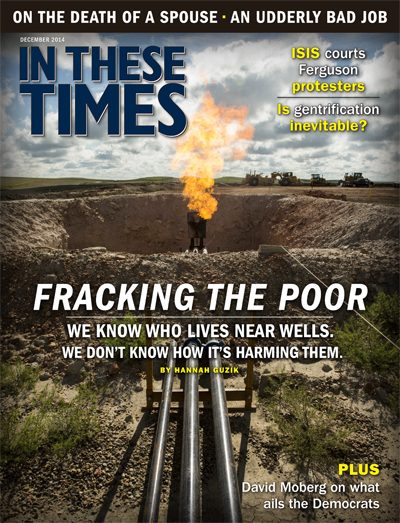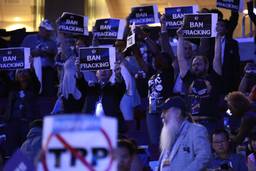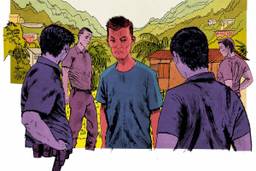Fracking the Poor
A 5-month investigation reveals that fracking operations in California are disproportionately concentrated in poor communities of color—and may be causing alarming health effects.
Hannah Guzik

It was supposed to be a good day. It was the first day of school and Johanna Romo, 12, had just woken up. It was already hot, and if she had looked out the window, she would have seen smog hugging the valley floor, obscuring the mountains, as it has almost every day this year. But she didn’t have a chance to look out the window.
As Johanna sat up and prepared to put on her school uniform — a blue shirt and khaki pants — her body lurched backward onto the floor, violently shaking.
She would never make it to class that mid-August morning, the first day of seventh grade. A few weeks later, another seizure followed, and Johanna was hospitalized for three days while doctors ran tests and scanned her brain.
Johanna lives in Shafter, a small, heavily Latino town in California’s Kern County. Kern is one of 19 counties in the Central Valley, an arid, sunburned place between the Sierra Nevada and Coast Ranges, home to farms that grow a third of the nation’s produce. It is a place haunted by extremes — extreme heat, extreme drought and, in many areas, extreme poverty. There is also, under the earth’s crust, an extreme amount of oil — the Monterey Formation, estimated to be among the most oil-rich resources in the United States.The nation’s oil companies have set up shop in this cradle of California, drilling and fracking in thousands of locations, including one about 100 yards from where Johanna attended elementary school. That’s where she first began getting headaches and nosebleeds.
Johanna’s family believes that fracking and its associated environmental pollutants are at least partially to blame for her health problems and those of others in their town, where the grape and almond farms are pocked with oil wells.
Oil has been siphoned out of California for more than a century, mostly from the Central Valley, which produces more than 80 percent of the state’s oil. Oil companies have also been fracking in California for at least six decades. Here, the practice is typically used to extract oil, unlike the fracking for natural gas that’s been booming in other states.
The development has driven down property values in many of the oil-rich regions of California. “The cost of living in these potentially blighted areas may make it more feasible for people with fewer means to be able to live there,” explains Seth B.C. Shonkoff, a public health scientist and executive director of PSE Healthy Energy, a nonprofit that brings scientific transparency to energy policy decisions. Land in the Central Valley goes for as little as $2,000 an acre, and the valley contains some of the poorest counties in California, many of which have large Latino farm worker populations.
An analysis by the nonprofit FracTracker Alliance conducted for In These Times found that the 5 million California residents who live within a mile of an oil or gas well have a poverty rate 32.5 percent higher than that of the general population. Overall, FracTracker found that almost 20 percent of Californians who live below the poverty line — more than 700,000 people — also live within a mile of a well.
A related FracTracker analysis for an October report by the Natural Resources Defense Council (NRDC) found that of the Californians who live within a mile of a well, 69 percent are people of color. In addition, almost 2 million people who live within a mile of a well are classified as among the “most vulnerable” to the effects of pollution by CalEnviroScreen, a tool developed by the California EPA. That means that they not only reside in some of the most polluted areas of the state, close to industrial facilities, transportation corridors, hazardous waste facilities and toxic cleanup sites, but are especially sensitive to pollution because of factors like poverty, asthma, youth or old age. Nearly 92 percent of these most vulnerable 2 million are people of color.
“California’s communities of color have long been dumping grounds for industrial pollution — and our analysis shows that fracking is poised to pile on more if the oil and gas industry has its way,” wrote Miriam Rotkin-Ellman, a senior scientist at the NRDC.
What all this means is that low-income communities of color are bearing the brunt of California’s oil industry — including its fracking experiments, which are poorly regulated and whose health impacts are largely unknown.
“It’s a civil rights issue,” says Abre’ Conner, the staff attorney at Kern County’s Center on Race, Poverty and the Environment. “When we look at where the fracking wells are being located,when we look at the health impacts across the state of California and really across the country, we see the same types of issues and the same types of disparities that we’ve seen with education and voting rights.”
Oil country
According to data compiled by FracTracker, more than 80 percent of the 2,904 fracked oil wells in California are located in Kern County, which has the third-highest oil production per day of any county in the nation. It is also among the poorest counties in California; according to census data, 22.5 percent of residents fall below the poverty line, significantly more than the 15.3 percent statewide. Kern is home to many recent immigrants and farm workers; about 51 percent of its 865,000 residents are Latino. According to the NRDC study, three-quarters of Kern residents living in a polluted area and within a mile of a well are people of color, while communities that are in less polluted areas and farther from wells are majority white.
In 2010, oil companies contributed 34 percent of Kern County’s private sector gross domestic product, or $8.3 billion. The mascot at Bakersfield High School, painted tall on a building overlooking California Avenue, is the Driller. This is a place where as many oil supporters showed up at the local Episcopal church to protest a screening of the anti-fracking documentary Gasland Part II as did those interested in the film. This is a place with an unincorporated area called Oildale. This is a place where, when the county held a meeting to discuss a refinery expansion, dozens of union workers came in their boots and Carhartts to show their support for the project and for the 200 jobs it would bring. This is a place that has voted Republican in every presidential election since Lyndon Johnson was elected in 1964. Sometimes called “Texas West,” this is a place where people grow up with agriculture and oil in their blood, where using the land now for jobs to the possible detriment of the future sounds to many like a necessary plan — like the only plan.
“I’m for anything that will bring revenue and money to the city,” says Morgan Suycott, a retired university counselor, as he stands outside the Kern County Board of Supervisors chambers in Bakersfield, waiting for a board meeting about a proposed refinery expansion that would allow trains to bring in Bakken crude for servicing. The board unanimously approved the project that afternoon, to the applause of more than 100 supporters in the audience.
Johanna’s father, Rodrigo Romo, understands the need for jobs. He’s been unemployed for more than four years since seriously injuring his leg at the roofing factory where he worked. Romo, 37, who started a community garden last year in Shafter and attends college classes to improve his English, wants what’s best for his family and his community, whatever that ends up being. And he wants information. “They don’t tell us nothing,” he says of the fracking operations. “I understand it’s very complicated, but they should still tell us something. It feels like one person can’t fight with the bigger companies and the oil and the government.
“I’m very concerned about my daughter,” Romo says. “A few months ago, another girl, a friend of my daughter’s, she passed away for no reason. My daughter said, ‘I don’t want to die like my friend.’”
At a neighborhood meeting in early September at Romo’s community garden, which is next to Johanna’s elementary school, children practiced cheerleading on the grass and a dozen gardeners gathered around a picnic table talking. Many say they believe their family’s health has been affected by the oil development. They talk about asthma and unexplained illnesses, some fatal. Rosario Garcia, a volunteer at the garden, says that four years ago, his 9-year-old son, Miguel, developed asthma, which he thinks may be related to the pollution in the valley. “It scares me very much,” Garcia says. “The first time he got purple and tried to jump to try to get air.”
Belen Lopez, who is raising four children in Shafter, says she worries about her kids attending school near fracking and waste wells. Sitting next to Lopez, Teresa Tutor says she’s thinking of moving because the oil production noise and air pollution have gotten so bad. Some of the other community members nod, silently. What goes unsaid is that not everyone has the financial means to move.
Fracking unknowns
According to the American Lung Association, the Central Valley and the Los Angeles Basin have the worst smog in the nation. Walled on three sides by mountain ranges, the valley traps agricultural emissions and exhaust from the freeways. Oil production, which releases toxic chemicals from wellheads and brings belching machinery and trucks, makes the smog worse. Residents of these heavily polluted communities already suffer high rates of pollution-related illnesses such as asthma.
“When you add [oil and gas] wells to the Central Valley, which already has one of the worst air pollution rates in North America, you’re adding to the burden of smog and pushing it way into the danger zone,” says Sandra Steingraber, a biologist and the author of Raising Elijah: Protecting Our Children in an Age of Environmental Crisis.
In addition to increasing smog-related breathing problems generally, fracking may also pose additional health dangers through local air pollution and chemical contamination. Could it be causing Johanna’s seizures? Much of the information needed to answer that question is shrouded from public view. “The problem is that this industry surrounds itself with so much secrecy,” says Steingraber. “Unlike any other industry, it’s not required to tell us what chemicals are being released into the environment, and also it’s not required to measure and monitor cumulative air emissions. … For that reason, public health science has to work with one hand tied behind its back.” The oil and gas industries have long enjoyed exemptions from federal laws like the Clean Water Act and the Safe Drinking Water Act, meaning that, when it comes to fracking, “they aren’t required to monitor and report what chemicals go in or what chemicals come out,” explains the NRDC’s Rotkin-Ellman.
Scientists do know that fracking — both for oil and natural gas — can release a number of toxins and carcinogens into the environment, including arsenic, benzene and toluene. While non-fracked oil wells also can cause such environmental contamination, the fracking process may increase the risk, says Rotkin-Ellman.
Each of these compounds has known health effects. Exposure to high levels of arsenic in the water supply is associated with skin lesions, cancer, developmental problems, cardiovascular disease and diabetes, according to PSE Healthy Energy’s Seth Shonkoff. Elevated exposures to toluene in the air can negatively affect kidney, liver and nervous system function, and can lead to some types of heart disease. Toluene can also irritate the skin and eyes. Benzene, which nearly all field studies find in elevated concentrations in the air around oil and gas developments, has no safe threshold, Shonkoff says. In high concentrations, benzene can lead to the development of certain types of leukemia and is also linked to adverse birth outcomes, including neural tube defects. Theoretically, in high concentrations or with chronic exposure, either benzene or toluene could cause seizures like those Johanna has experienced.
What’s still not fully understood, however, is the extent of the chemical contamination from fracking, and to what degree it is affecting public health. Scientists are hampered not only by the lack of information from industry, but also by the difficulty of teasing out the effects of other pollutants, the slow emergence of diseases like cancer and the challenges of collecting medical information and accumulating significant sample sizes in rural areas.
Meanwhile, the oil and natural gas industries maintain that fracking is perfectly safe, and indeed, at least one industry-funded study found no correlation between oil and gas development and public health risk. But a handful of peer-reviewed scientific studies have found that people living near oil and gas operations are at an increased risk of certain health problems, including cancer, respiratory diseases, skin infections and adverse birth outcomes. A Colorado study published in 2012 found that people living less than half a mile from natural gas wells, many of which were fracked, were at a greater risk of health problems and cancer than people living farther away. The hydrocarbon emissions from oil and gas development “can result in elevated air pollution concentrations that exceed U.S. EPA guidelines for both carcinogenic and non-carcinogenic health risks,” wrote Shonkoff about the study, as part of a review he co-authored in August. A study published in April by the same Colorado researchers found that pregnant women living within 10 miles of natural gas wells in Colorado, many of which were fracked, were more likely to deliver babies with congenital heart and neural tube defects.
No one has conducted a study in California on the health effects associated with oil and gas development, Shonkoff says, much less in the small town where Johanna lives. Because of our limited understanding of how the body interacts with toxins in its environment, and because there are so many other social, behavioral, environmental and biological factors at play, it’s difficult to determine whether Johanna’s health problems are — or are not — the result of fracking.
“The burden of proof is on the victim,” says Tom Frantz, an almond farmer who lives in Kern County and knows Johanna’s family. “So there’s nothing they can do.”
Whose backyard?
As fracking has grown and grabbed headlines around the country, some states and municipalities have passed laws to shield residents from potential health effects. Colorado recently adopted new regulations, among the strongest in the country, that require oil companies to fully report the fracking chemicals they use. In New York state, more than 170 communities have enacted bans or moratoriums on fracking.
Others, however, have passed laws shielding companies from regulation. North Dakota legislators have requested that the state be exempt from federal fracking rules, and Pennsylvania enacted a pro-fracking law in 2012 that, among other things, sought to strip communities of their right to use local zoning laws to limit oil and gas development. (A group of seven municipalities successfully sued to overturn this portion of the law.)
Many local ordinances ask or require companies to report the chemicals they use in fracking. Oil and gas companies in Mississippi, Montana, Oklahoma, Texas, Pennsylvania, North Dakota, Colorado and Louisiana report at least some of those chemicals on FracFocus.org. However, the data has been criticized by a Harvard University study because it involves self-reporting, and thus there’s no way to know whether disclosures are being made quickly or fully.
In California, local governments have the ability to regulate natural resources within their boundaries. This has led some cities to ban or strictly limit fracking wells, including Arroyo Grande, Berkeley, Beverly Hills, Los Angeles, San Luis Obispo, San Francisco, Santa Barbara and Sebastopol, as well as the counties of Marin, Mendocino, San Benito and Sonoma. Most of these cities and counties are wealthy and educated. That pattern extends beyond California. “In parts of the country, populations with a higher socioeconomic status have successfully advocated for stronger regulations or moratoriums or bans,” Shonkoff says.
Indeed, in most of California, including Kern County, no local fracking regulations exist. A few low-income cities in the state, such as Compton, have instituted their own moratoriums on fracking, signaling that the tide can turn even in poor areas if there’s enough support and mobilization. But it’s difficult. The oil and gas industry has spent over $77 million lobbying California policy makers in the last five years, according to reports filed with the California Secretary of State. When pitted against a deep-pocketed industry, low-income communities often lack the information, organizing power or resources to stop wells from appearing in their neighborhoods. Locals often don’t find out about new wells until after they are operational. “We see [oil companies] trying to keep people from being educated,” Conner says.
Meanwhile, as fracking continues to expand to more wells in California, the infusion of money and jobs is attractive to struggling cities, such as those in the Central Valley. State legislators who represent the region, including the cities of Fresno and Bakersfield, have held forums to discuss the benefits of fracking.
Last year, California Gov. Jerry Brown signed a bill, SB 4, that imposes statewide regulations on the fracking industry — which had previously been nearly ungoverned. Among other things, beginning in July 2015, companies will have to send notices in English and Spanish to residents living within 1,500 feet of a wellhead before fracking begins. At present, Conner says, some oil companies send English-only notices to Kern County residents, despite the fact that 42 percent of families in the county speak a language other than English at home, according to census data. (In Shafter, where Johanna lives, that proportion is more than 70 percent).
Drinking fracking’s waste
According to Shonkoff, the greatest likelihood of exposure to chemicals from oil and gas development is probably through the air. But public health experts are also concerned that fracking can contaminate groundwater. The worry is not just about fracking itself, but about the disposal of the billions of gallons of waste the process generates, which includes drilling mud, oil, water and fracking fluids — a toxic soup of chemicals. In one disposal method, also used for wastewater from other methods of oil and gas production, various mixtures of these byproducts are injected into the earth in waste injection wells. A 2012 ProPublica investigation found that the EPA has failed to properly protect aquifers from pollution from injection wells and has granted more than 1,100 exceptions to the Safe Drinking Water Act. Many of these exemptions still stand today, particularly in California, which, according to Frac-Tracker’s data, has 1,105 waste injection wells — three-quarters of which are situated in Kern County. While SB 4 requires oil companies to notify residents of their intent to frack wells nearby, there’s no such requirement for fracking disposal wells.
With California in the midst of a 100-year drought, water contamination from fracking is a hot issue. This summer, the state launched an investigation into the matter and shut down 11 waste injection wells out of concern that they may be contaminating aquifers. The Central Valley Regional Water Board subsequently concluded that nine of the wells had been injecting waste into aquifers suitable for drinking and irrigation, which are supposed to be protected under federal and state law. The water board found high levels of arsenic, thallium and nitrates in drinking water wells near the injection sites. In a lawsuit filed against four oil companies this September, a Kern Country farm alleged that aquifer pollution had resulted in the death of its crops.
And then there are the unlined dumping pits for drilling waste, known as sumps. While the state keeps tabs on fracking disposal wells, it has failed to track sumps, and the Central Valley Regional Water Board estimates that oil companies have dumped drillingaste into thousands of these pits since oil production began here in the 1890s. There is no publicly available map to locate past and current sumps, and there is no requirement that oil companies notify neighbors before constructing one.
The largest oil and gas producer in California and Kern County, Occidental Petroleum Corporation, says it is confident that its sumps and waste injection wells do not affect underground sources of drinking water. Likewise, the Western States Petroleum Association, which represents all major oil producers in the West, says it’s not aware of any instances where waste injection wells or sumps have contaminated groundwater. “Fundamentally, I don’t think anyone has ever said that the process, when properly constructed, permitted and used, poses any risks to the water resources,” said spokesperson Tupper Hull in an interview in September. Hull did not respond to requests for comment on the water board’s findings of drinking water contamination.
Tom Frantz, who still lives in the house he grew up in just outside Shafter, says he spends about 40 hours a week assessing fracking operations and other environmental hazards in the town. It’s a hobby, says Frantz, a former math teacher, but really, it’s more than that: It’s a way to help his community understand what’s happening to it. In fall 2012, Frantz stood behind an almond tree and aimed a video camera at a sump in Shafter. What he saw alarmed him. A white, soapy looking fluid was trickling into the pits that were only supposed to hold drilling mud. Frantz posted the footage online and showed it to the water board, prompting them to investigate. The board found that Vintage Production California LLC, a subsidiary of Occidental Petroleum Company, had violated California’s water code by discharging fracking fluids into the sump. In a November 2013 settlement, the company agreed to pay a $60,000 fine, but “without admitting that any violation occurred or that hydraulic fracturing products were put into any sump,” said Charles Weiss, a spokesperson for California Resources Corporation, another Occidental subsidiary.
In September, the water board announced another settlement agreement, this time with both Occidental and Vintage, after finding that they had illegally discharged a combined 79,464 gallons of fluids into unlined sumps over the course of nearly two years, ending in November 2013. The settlement calls for fining the companies $6 per gallon of discharge, a reduction from the $10 per gallon maximum fine, for a total of $476,784.
Proposed regulations under SB 4 would prohibit fluids related to well stimulation from being stored in sumps beginning in July 2015, according to the California Department of Oil, Gas and Geothermal Resources. In the meantime, sumps are still being used across the state, and advocates are concerned that they aren’t being regulated. “I don’t think I was so lucky to just go there one day and find them cheating on the only day they cheated,” Frantz says.
A family waits for answers
Since her first seizure, Johanna has had two more. Her older sister witnessed the second. When she saw Johanna’s eyes roll back into her head, she ran, screaming, to get their mother. The third seizure happened in the children’s hospital, where Johanna was admitted in early September. The doctors did a series of brain scans and tests, and, as of press time, were still trying to determine the cause.
Shonkoff says it’s possible Johanna’s seizures are the result of exposure to pollutants from oil and gas development, but it would be extremely difficult to find out for sure. “Epidemiological tools are especially blunt when trying to assess the health outcomes of an individual person,” he says, launching into an explanation of how we don’t know all of the chemicals involved, their concentrations, when or how Johanna was exposed, or any other environmental exposures, such as pesticides. “So that’s a very long-winded way of saying, ‘Sure, it is possible, but we don’t have enough information to say with certainty.’”
Cases like Johanna’s upset Shonkoff. “It is unacceptable to not have to disclose what chemicals you’re using across the street from somebody’s house,” he says. “It hinders our ability to understand and protect the health of our communities.” The fact is no one knows what is happening to Johanna. Fracking and its associated waste, as well as the state and federal government’s failure to properly regulate both, could be at play. Or maybe it’s coincidence. Ultimately, neither the oil companies nor the government are accountable to Johanna and her family.
Meanwhile, Johanna is being homeschooled because of her medical problems. She waits, and worries — about her health, whether she’ll have another seizure and what it might mean if she does. It doesn’t seem fair. “It’s hard,” she says one especially hot day, soon after coming home from the hospital. “I’m feeling tired.”
This article was supported by a grant from the Leonard C. Goodman Institute for Investigative Reporting.







